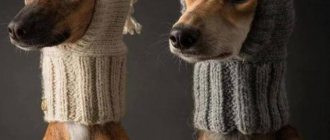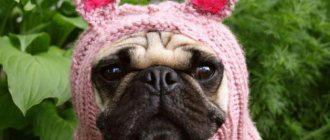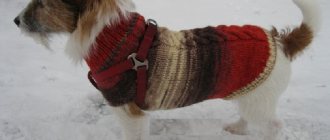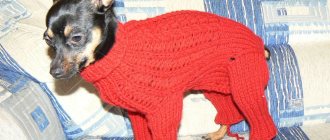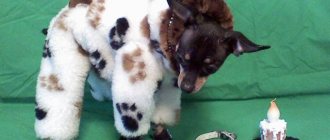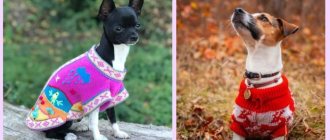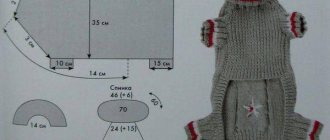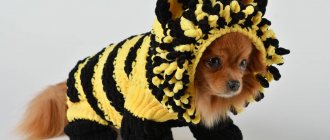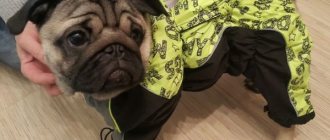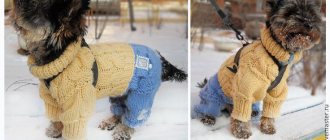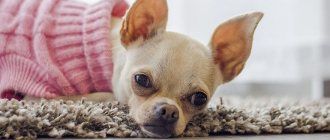Dogs become our best friends. They love us and protect us. We, in turn, must also treat them. It is our duty to make sure that our little and sometimes big friends feel comfortable in the winter.
There are now many specialized clothing stores open for dogs. Outfits are presented for every taste and color. Some people buy clothes just to dress up, while for others it is a vital necessity. But unfortunately for owners, things for their pets often cost them a pretty penny.
Knitting patterns for dogs, photo
In order not to spend extra money and spend your free time usefully, knit clothes for your little friends yourself. Show your imagination, add some decor and your sweater, for example, will be no worse than a store-bought one.
Features of sewing winter overalls
Both the first and second options can be made for winter. It is insulated using a fleece lining, fleece and synthetic fillers (sintepon, holofiber). The lining is cut and sewn in the same way as the main part, and then both parts are carefully sewn together from the wrong side.
You can sew the top with lining in several places (along the chest, waist or across) so that the jumpsuit fits well and does not “fidget” in different directions. In the winter version, the sleeves, neckline and tail cutout must be placed on soft elastic cuffs so that they fit more closely to the animal’s body.
The item can be decorated with fur, buttons, rhinestones and appliqués. Make sure that the animal cannot reach the decorative elements, bite off and swallow them.
Dog measurements for knitting
In order for a suit to fit well, dogs, just like people, need to have their measurements taken. You should not mistakenly focus on the standard size indicators of a particular breed. All dogs are individual.
To take your measurements correctly, use our table.
Features of knitting a sweater for a dog on knitting needles
How to knit a sweater for a dog? Main stages of work:
- It is necessary to take all necessary measurements in advance.
- Make a pattern drawing using a special pattern. Please note that the back of the sweater is always wider than the front.
- Before starting work, it is useful to knit a piece of fabric measuring 5 by 5 or 10 by 10 cm. Use threads and knitting needles intended for this product.
- At each stage, fittings should be carried out and calculations adjusted: it is easier to remake a thing at an early stage of production.
Important! Washing and ironing of the finished product is carried out taking into account the recommendations on the ball of thread.
Knitting patterns for dogs
Pros and cons of knitted clothes
For dog owners who are familiar with knitting needles and also know how and love to knit, knitting a warm item for the cold season for their pet is a pleasure. Let's list the advantages of hand-made knitted clothes:
- Hand-knitted clothes are always fashionable.
- This will cost much less than store-bought pet clothing.
- No need to run around the shops looking for the right size, color, style.
- Knitted clothes will be made in a single copy.
- The clothes will be tailored exactly to size, that is, made to order: the chosen model, knitting pattern, length of the product, accessories - everything will satisfy exactly your wishes.
- From one skein of yarn you can knit not only a sweater or blouse, but also other accessories (hat, beret, scarf).
- In this outfit, your pet will stand out among others.
There are also disadvantages, but they are few and can be easily eliminated:
- Hand-knitted wool products stretch over time. This is very easy to fix by adding a simple thread to the knitting or buying yarn with a small percentage of artificial fiber.
- When worn and washed, “pillings” form on clothes. But they can be easily removed using a safety razor or a special device.
So, there are some advantages, it’s time to start choosing yarn.
We recommend this article:
What to buy and how to make clothes for a pug with your own hands
Sweater for a dog, photo
Purpose of clothing for dogs
Cute dog clothes were originally designed for purely practical purposes. We will talk about what functions it performs in this chapter.
Protection
Most of the original raincoats, overalls and even shoes for dogs were made of strong, waterproof material. Thanks to them, the animal’s fur and paws remain dry and clean during rain, when walking in the park or forest. Some garments also have strong cuffs that allow the garment to fit tightly to the limbs. This way, owners eliminate the possibility of parasites (ticks) getting on the pet’s body.
Thanks to the overalls, the animal's fur always remains clean
Support
Some dogs require support belts and overalls. This is especially true for animals with diseases of the musculoskeletal system, as well as those who have recently undergone surgery.
Heating
Despite their thick fur, dogs also get cold in winter. Warm clothes help them stay warm in cold weather, increasing the duration of their walks in the fresh air.
In winter, a jumpsuit will help your dog stay warm
beauty
Recently, items of clothing similar to human ones are increasingly used by owners to decorate their pets. On the streets you can often see dogs in shorts, T-shirts and caps, with bows, and in carnival costumes. Similar clothing is also used at dog festivals and exhibitions, and photo shoots. The most commonly decorated dogs are decorative indoor breeds, which include Yorkshire terriers.
Clothes may simply have a decorative function
How to knit a dog sweater for beginners, diagram with detailed description and photo
For beginners, you can knit this simple dog sweater from warm melange yarn. We will take thick threads, two hundred meters in one hundred grams of yarn. You will need number four knitting needles.
Yarn for work:
First, take measurements from the dog, use the table and description given above. After this, you can start knitting the collar. Try not to make it too tight; the sweater should be easy to put on and not cause discomfort to the dog. The optimal collar width for small dogs is five centimeters. We knit it with a 1x1 or 2x2 elastic band.
We knit the main part of the sweater with a simple stockinette stitch. You can put a pattern in the form of a braid along the back. We will knit the pattern on 17 loops. At the end of the collar, you need to count this number of loops in the middle and knit the pattern according to the diagram below. If you still find patterns difficult, you can knit the entire sweater using satin stitch.
After two rows of the main fabric, we begin to add. Add two loops on each row. We add loops until the width of the fabric reaches the size of the dog in the chest circumference, plus another two centimeters for allowances. Be sure to try the sweater on your dog. To make this easier, place the stitches on circular needles. Then put it back on the stockings. Don’t be lazy to try it on again, so you don’t have to start all over again.
If everything worked out and fit, then we knit three more rows without additions.
Now you need to make slots for the paws. As shown in the photo, you need to skip the number of loops you need in size, knitting only the side parts from the holes. To do this, knit the first three centimeters, close the next six centimeters, and then knit to the second armhole. And when you get a suitable <<sleeve>>, add air loops and knit further with a single piece of fabric.
Now we need a measurement from the abdomen, length. The fabric tapers towards the bottom of the tummy, so you need to decrease two loops every six rows. Don't forget to try the product on your dog.
Having reached the required length, finish the edge with an elastic band. Six rows are enough. The armholes for the paws would also be good to tie, you can crochet them. The last stage is assembling the sweater, sewing it and trying it on the owner.
Selection of yarn and tools
A dog pullover can be made from the following yarn options:
- Cotton combined with viscose can be chosen for summer or autumn.
- Linen or bamboo are good in the off-season.
- Soft wool mixed with acrylic is perfect for winter.
Circular knitting needles are the main tool for knitters. But needlewomen who do not know them may well use another means, in particular, a hook.
Attention! The diameter of the knitting needles should correspond to the thickness of the yarn.
The yarn must be of high quality
Crochet pattern for dogs overalls, details
We will crochet number five. You can take the same white or milky yarn (Cinse Artico), or you can choose something brighter. You will also need a pink ribbon, about forty centimeters, and one pearl bead.
We knit according to the pattern: air loop, connecting column, single column. and a column with nak.
Before.
We start knitting the fabric from the waist line. We cast on 81 loops and close it into a ring. Next, using pattern number one, we knit seven centimeters in a circle. Next, the canvas needs to be divided into two parts. The bottom consists of 14 motifs, and the top of 12. Leave 2 motifs between them on both sides. for the armhole. We knit everything according to pattern number one.
Bottom part.
After 10 cm has been passed from the armhole, set aside 7 motifs in the center for the neckline. We knit the right and left parts separately. After 14 cm from the armhole, finish knitting. We knit the second side in the same way.
Top part.
After 10 cm has been passed from the armhole, set aside 6 motifs in the center for the neckline. After 14 cm from the armhole, finish knitting. We sew the details of the bottom and top along the shoulders. The neckline or neckline needs to be tied. To do this, in a circle, first knit 2 rows with single stitches, then 2 rows with stitches. with nak. Use scheme number two.
All that remains is to knit the sleeves and the bottom of the overalls. First we knit the sleeves for the front legs. To do this, we raise the post in the armholes. and knit in circular rows of 10 centimeters using pattern number one. Then make a 4 centimeter column with a nak. according to scheme number two.
Let's move on to the bottom. From the first row along the waist line we knit 20 centimeters according to the first pattern. Then set aside 11 mot. in the middle under the hole for putting on. We knit the left and right sides separately 7 centimeters. At the same time, we perform a decrease, 2 columns. from each side. We sew together the parts of the fabric, not forgetting to leave an opening for putting on and armholes for the paws.
Using the first pattern, we knit in the armholes for the hind legs in a circle of 7 cm. Then make a column cuff without tape. 2 cm.
According to the third pattern, we tie the bottom of the overalls. We make a bow from the ribbon and decorate it with a bead.
Step-by-step description of knitting a sweater for a pet
Below is the process of creating a sweater for a Yorkie with your own hands (diagram), which even a beginner in knitting can easily reproduce.
Note! P – loop, n – yarn over.
It is necessary to prepare the tools:
- Knitting needles No. 3 (3 pcs.).
- Yarn in two/three colors.
- Notebook.
- Pencil.
- Needle with a wide eye.
- Scissors.
A schematic drawing of the future product is made
Gate
You should start from the gate. You will need to cast on 71 stitches with yarn No. 1. Next, knit an average of 16 rows with an elastic band, alternating knit and purl stitches. The tail of the thread is threaded and the end is cut off.
Tummy
Next comes the creation of the tummy. It starts from 25 p. You need to take a different color of yarn (No. 2).
1st row: knit stitches, 14 n between them.
2nd: simple elastic band.
3rd: remove the first stitch, make 1 n., 37 elastic stitches; 1 n., finish purlwise.
4th: elastic band.
5, 7, 9th: repeat 3rd row.
6, 8, 10th: rubber band method.
Sleeve Armholes
From the 11th row, the armholes of the dog sweater sleeves begin. You need to close 3 sts, then elastic.
12th: bind off 3 stitches, knit an elastic band.
13-27th: elastic band unchanged.
28th: set of 3 chain stitches.
29th: similar. It is necessary to continue knitting the belly to a length of 11.5 cm from the collar.
Change the color to the original (No. 1) and create 2 cm in length. Close all items.
Back
Now the back - there are 46 stitches on it. You need to take a thread of the main color (No. 3).
1st row: knit 23, knit 1, knit 23.
2nd: purl stitches.
3rd: remove first p., n., knit 45; make n., purl.
4th: purl method.
5, 7, 9th: repeat 3rd row.
6th, 8th, 10th: purl knitting.
11-12th: cast off 3 sts.
13-27th: alternate knit and purl rows.
28th: set of 3 chain stitches.
29th: similar. It is necessary to continue the front and back rows to a length of 16.5 cm. Then, on each front row, close 2 stitches from the edges. You need to lengthen the product to 22 cm and close the last row completely.
Attention! Sew the back and abdomen from the side with a wide-eye needle.
Create a trim with yarn No. 1, 2 cm wide. Close the row and sew the trim to the bottom of the back.
Sleeves
Next comes knitting the sleeves. All colors are used in turn.
1st-3rd rows: thread No. 2, 40 p., elastic band.
4th: thread No. 1, add 1 n. at the edges. You need to take yarn of the main color - No. 3.
5th-7th: elastic band.
8th: 1 stitch from each edge. The sleeve is increased by 2.5 cm. The last level is closed.
According to the description above, you also need to create the second sleeve of the jacket.
Step by step, you first need to connect the sleeves on the sides, then sew them into the armholes of the vest from the inside out.
The Yorkie sweater is ready. All that remains is to check the seams and thread the stretched threads.
For a jacket you can add a collar or hood
This method of work is suitable for beginner needlewomen. It will allow you to create a beautiful and practical thing for your pet. A similar pattern can be used to knit, for example, a sweater for a toy terrier.
Additionally! The jumper can be insulated using a knitwear lining.
Knitting pattern for a dog hat, details with photos
Many people think that a hat on a dog is just a whim of the owners. But there are breeds that cannot live without a hat in winter. Therefore, it will be very useful to learn how to knit a hat for your little pet.
If you decide to knit a hat yourself for your little friend, then we offer the simplest step-by-step example. You can take this hat again and decorate it however you like. The measurements on the chart are for a medium sized Yorkie. You must take your own measurements.
Let's start with the hook
There are many techniques for crocheting. Let's look at two of them:
- Moroccan technology;
The use of this technique provides such advantages as the tightness of the knitted clothing and retention of shape for a long time. Typically, sleeveless vests, blankets and capes are knitted using this technique, which turn out very beautiful.
- Freeform knitting technique.
In this technique, first, a full-size pattern is drawn up and only then the elements of the future clothing are knitted. As a result, all elements are connected to each other using a thread or hook. The freeform knitting technique will take a little more time, but it will be worth it. Clothes made using this technique are absolutely original and unique.
Article on the topic: Do-it-yourself cat pillows with knitting patterns and descriptions with photos
But what to do with the fact that crocheted dog clothes are not warm? This problem can also be solved, and there are several options for getting out of this situation:
- You can use a lining that is sewn from the inside out. It is important to note that this option will significantly complicate the washing process. However, if your pet also has other clothes, this will not be a problem;
- The second option is to decorate products with ornaments that can be embroidered on the finished item or knitted - this will help retain heat.
Knitting raglan for dogs, diagram with description
The simplest raglan diagram for clarity.
We will knit the sweater from the neckline. We cast on loops, the number of which corresponds to your measurements of neck volume. There are 64 stitches cast on in this tutorial. Divide them into four spokes. Knit the neckline with an elastic band two by two 15, and in order to get a lapel about 20 rows.
Let's go directly to the raglan. To get raglan in the future, divide your number of loops by three. They need to be distributed into loops for the back, front and legs. If you divide 64 by three, you get about 22 loops.
Since the back is wider, we will leave 25 stitches for it, 19 for the chest, ten for each leg, 20 in total. Then it is convenient to use special markers for knitting to delimit the details.
For sleeves, you need to calculate the number of loops based on the girth of the paws. For now we put these loops on another knitting needle. Then we continue to work in circles. On the knitting needle you are working with, cast on five to ten stitches so that the sleeve is not too tight. Close the circle and knit further.
We need to knit two hearts on the back. Where the pattern will be located and its size, choose at your discretion. The pattern is knitted according to the pattern.
After you complete the pattern, knit further in the round. The length of your sweater will depend on your dog's measurements, but remember that the back is always longer than the front. Once you have decided on the length, start knitting the elastic two by two. So we knit about seven rows and close the loops on the stomach, leaving the back.
Transfer all the loops to one knitting needle and continue working alternating faces. and purl rows. At the same time we make a decrease. We knit three loops together both at the beginning and at the end of the rows. You will get a smooth narrowing.
Only the sleeves remained. We remember those five or ten loops that are needed so that the sleeve is not tight and is free. Thread them onto knitting needles. Knit in a circle with a two-by-two elastic band to the length you need.
We knit for small breed dogs: why?
Knitting clothes for dogs has the following advantages:
- knitted items are fashionable, stylish and creative;
- the opportunity to save on expensive brands;
- the owner herself “selects” the size for her pet;
- for the whole thing you will need only one skein of yarn, even if you are crocheting a sweater for a large pet;
- A knitted animal sweater can also be unraveled and knitted into the most interesting pattern.
Regardless of the large number of advantages, it is necessary to present the disadvantages - the possible stretching of the tied item, as well as the formation of pellets on the product. Both disadvantages appear when only natural wool thread is used. To get rid of these problems, it is recommended to knit clothes from acrylic, a mixture of wool and acrylic (in this case it is not necessary to maintain a 50/50 proportion).
The following is a detailed master class with photos of knitting a sweater for a dog. The clothing example is suitable for beginners, since a standard garter stitch and 1*1 elastic will be used.
Knitting a costume for dogs in detail with a description
Such a simple suit in appearance and execution will look very beautiful and bright on your pet.
Having reached the armpits of the front legs, change the knitting needles to circular ones.
Having closed the loops, do not cut the thread.
How to take measurements correctly
Any pattern is based on the measurements taken. Inaccurate measurements will result in an ill-fitting item or the wrong size. The final result of the work will depend on how correctly you do this.
An important rule: all measurements are taken from the dog in a standing position!
First of all, take 3 pieces of soft, thin elastic. Tie one around the neck where the dog usually has a collar. The second elastic band goes around the chest, then around both front legs, up the sides and tied on the back. The third tag is tied at the waist - in the thinnest place in front of the hind legs. We get three main marks for further work.
Measuring the dog:
- Using the first mark we measure the circumference of the neck;
- We measure the circumference of the chest immediately behind the front legs along the widest part;
- We measure the waist using the third mark;
- the back is measured from the first mark to the beginning of the tail;
- the distance between the front and back paws (horizontal line parallel to the floor);
- for boys, measure the distance from the front paws to the genitals;
- paw circumference (front and back);
- measure along the chest the distance from the neck (first mark) to the front paw;
- the distance between the paws along the chest;
- the length of the front and rear legs (may vary depending on the product and your desire);
- back width - measure from the beginning of the right front paw to the left, across the back;
- width of the pelvis - removed similarly in the area of the third mark.
It may be useful to measure the distance from the first to the second mark, from the first to the third, from the second to the third mark. The volume of the tail can also be useful.
A complete DIY wardrobe for your Yorkie
In the summer, you can pamper your Yorkshire Terrier with a light cotton tandem of several things at once. They can be sewn as independent items, or the fabric can be selected so that they become elements of a one-piece suit.
Video - DIY dog T-shirt
T-shirt pattern
It is advisable to sew a T-shirt from cotton material with a light percentage of elastane so that the product has a slight stretch. This will make it easy to put it on the animal over the head.
Tip: if the fabric is not stretchy, you can add snap fasteners to the T-shirt - they are sewn in the places of the so-called straps of the T-shirt. The straps are not sewn together.
Mike needs to sew according to the following rules:
- According to the template, you need to cut out 2 parts of the product - the chest part is indicated in blue and markers with the number 1, the back - in black and markers without numbers. Both parts are turned with the front part up;
- in the image, the markers correspond to the measurements: AB - 1/3 of the neck circumference, A1B1 - 2/3 of the neck circumference, BV/AZ/B1B1/A1Z1 - distance from the neck to the base of the front paws, VG/B1G1/ZZH/Z1ZH1 - half-circumference of the base of the front paw , GD/G1D1/ZHE/ZH1E1 – distance from the base of the front legs to the base of the hind legs (shirt length), DE – 2/3 of the chest circumference, D1E1 – 1/3 of the chest circumference;
T-shirt pattern
- the armholes of the sleeves (VG and V1G1), the neck (AB and A1B1) and the bottom (DE and D1E1) must be processed with an edge seam - for this, when cutting the parts, you need to take into account seam allowances;
- in the places indicated by arrows in the diagram, the parts are sewn together (sections BV and B1B1, GD and G1D1, EZh and E1Zh1, ZA and Z1A1).
Ready-made T-shirt for Yorkie
On the back or collar you can decorate the product with a sewn bow, as in the picture.
Cap
It is worth noting that this headdress is suitable for most small breed dogs. It is better to make it from light but dense fabric that holds its shape well.
You will need non-standard measurements - the circumference of the animal’s neck directly under the chin (the sum of segments BV, GD and EA) and the circumference of the animal’s head from the chin to the top of the forehead (AB). The length of the visor can be arbitrary or equal to the distance between the animal’s eyes (K1K2).
The procedure for sewing is as follows:
- in accordance with the pattern, it is necessary to prepare 2 parts: the cap itself and the visor;
Pattern and finished cap for a dog
- in the places indicated by the dotted line (BV, GD, EA), allowances of approximately 1 centimeter must be left. When added together they form the girth of the neck;
- both parts need to be cut out and processed along the edge with an edge seam;
- in the dotted areas, the fabric is folded and stitched so as to form peculiar loops. Through them you need to thread a rope-tie, which will hold the cap on your head;
- the visor is sewn to the product at the location where similar points are marked on both parts (K1K2).
To fix the cap on the animal’s head, you need to loosely tie a rope under its chin in a bow.
Skirt
A full tulle skirt for a Yorkshire Terrier is one of the cutest pieces of clothing. Moreover, it is incredibly easy to sew; just measure the animal’s waist circumference.
Tulle skirt for a dog
For sewing, you will need a cotton ribbon about 3-5 centimeters wide, 2.5 times longer than the waist circumference, and a wide tulle ribbon 2-3 times longer than the circumference. The length of the tulle should be approximately equal to the length from the waist to the tip of the tail. The material should not be too long, otherwise it will interfere with the dog's walking.
Sewing a skirt takes place in several stages:
- The edges of the tape are folded in approximately 5 millimeters on each side and processed with an edge seam;
- on the total length of the tape, measure the length of the girth so that on both sides there are free segments of the same length (future ties);
- In the measured area, tulle is sewn to the lower half of the ribbon, laying it in folds under and on itself. To distribute the folds evenly, you can immediately sew the beginning and end of the tulle piece to the tape, and then proceed to laying and securing;
- after the tulle has been completely sewn, the upper part of the ribbon is placed exactly on the lower one along the entire length and sewn.
The belt can also be made with Velcro. In this case, its length should be equal to the waist circumference. In addition to the skirt, you can tie a matching tulle bow on the animal’s head or neck.
Taking measurements
In order to sew high-quality and comfortable clothes for your animal yourself, you need to decide on the measurements. For cutting you will need the following parameters:
- neck girth;
- back length;
- depth (girth) of the chest;
- waist circumference (the narrowest part of the body);
- girth of the hind and front legs (each separately) – if the item of clothing requires sleeves or legs.
Important measurements for sewing clothes for a dog
In order to correctly measure your dog, pay attention to the following details:
- The measurement of the neck is carried out at its widest point - for this you need to wrap the meter tightly, but not tightly, around it;
- The length of the back is measured from the base of the neck to the base of the tail. The dog is at rest in a standing position;
- chest circumference is measured immediately behind the front legs or at the point of greatest expansion, waist circumference - immediately in front of the hind legs;
- The girth of the paws is made directly at the base. If the presence of sleeves and trouser legs is expected, additional measurements of the length of the paws in an extended state are taken.
If the item is made from stretchy lightweight fabrics, you can use the original measurements. When cutting warm clothes using coarse materials, it is advisable to add 1-2 centimeters in volume so that the armholes do not put pressure on the dog and leave him freedom of breathing and movement. It is best to use a flexible measuring tape to take measurements.
Video - How to take correct measurements of a dog
The video tutorial shows in detail the process of taking measurements from a Yorkshire terrier.
